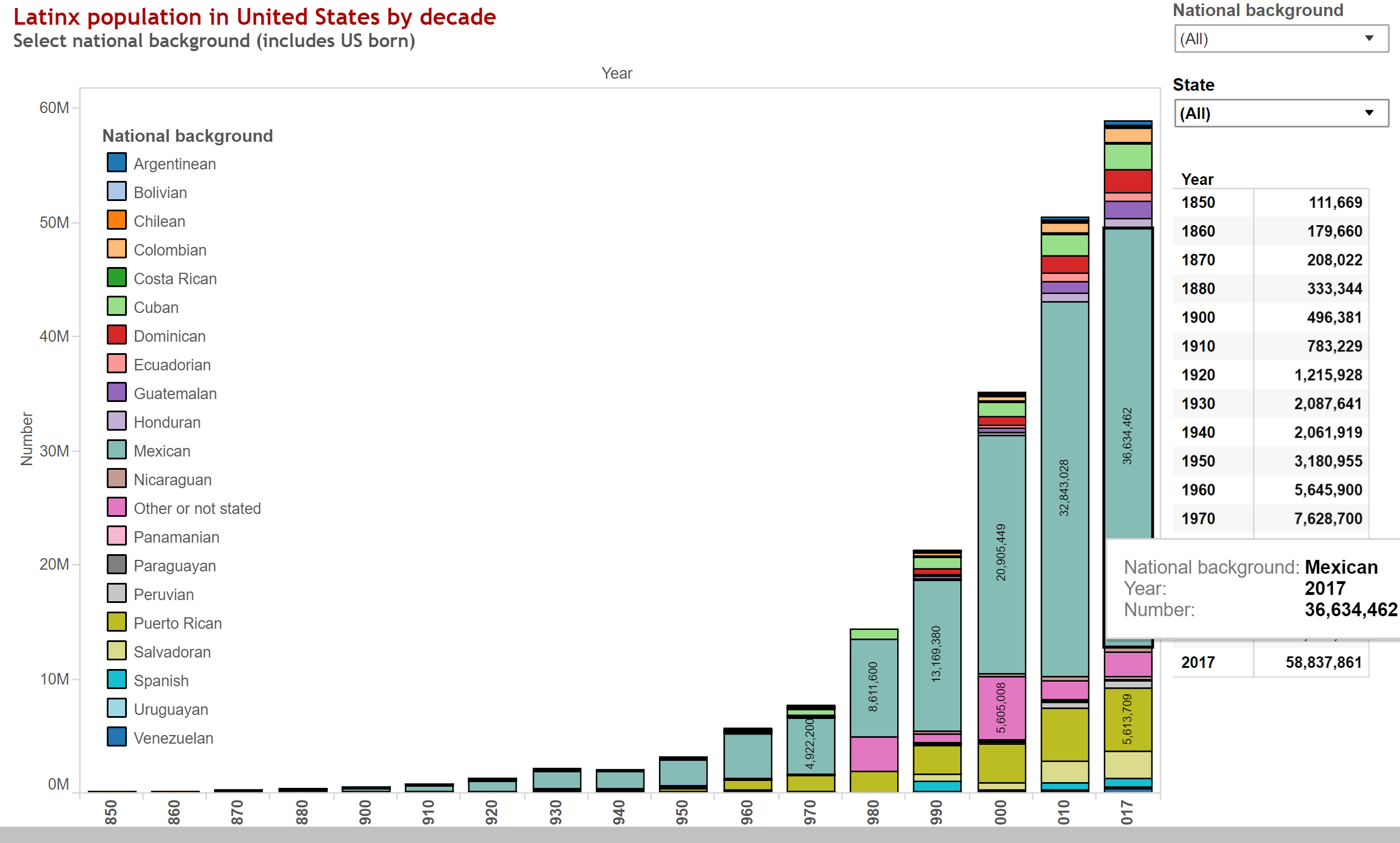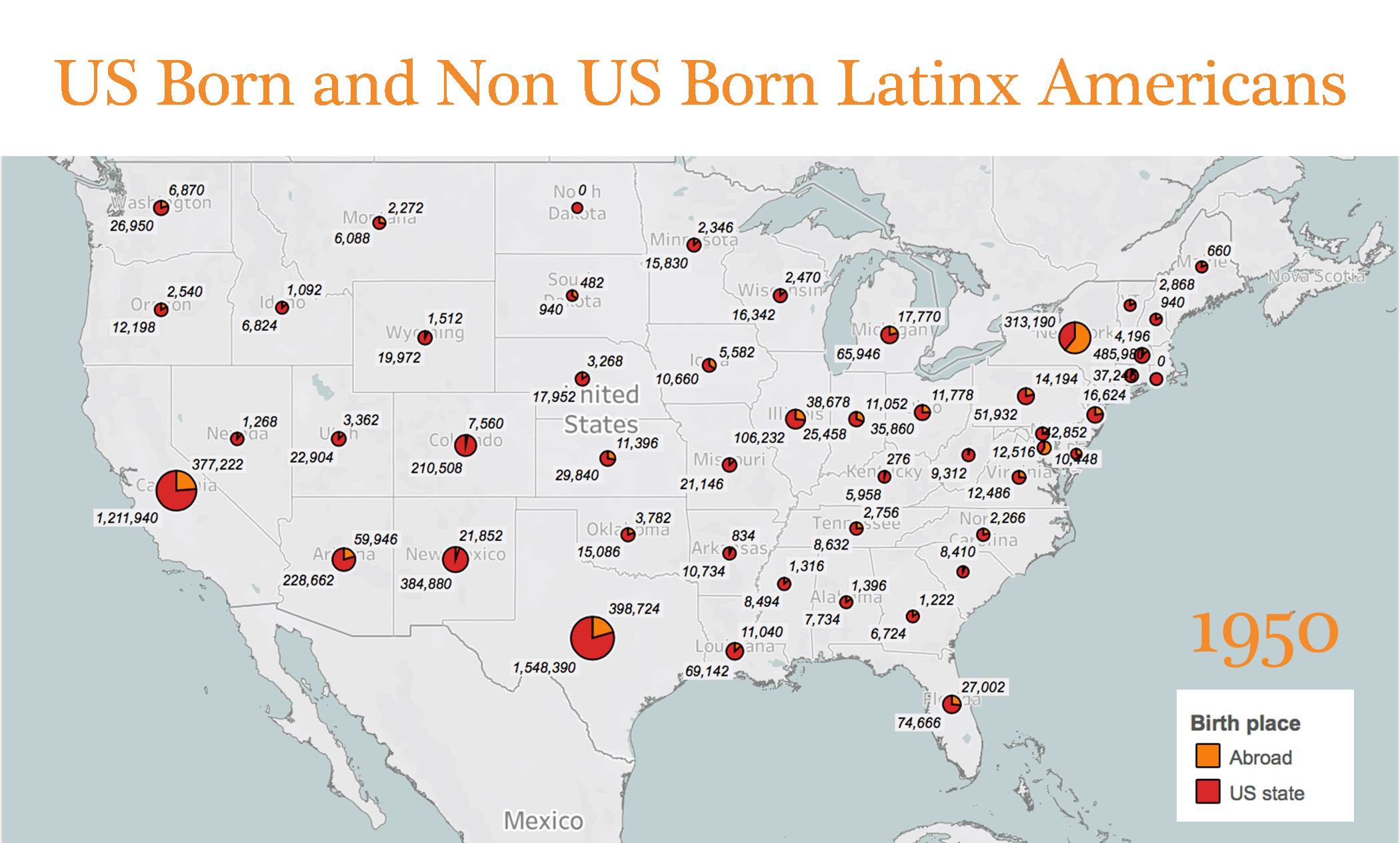by James Gregory
 click to explore interactive map of Latinx migrations 1850-2022
click to explore interactive map of Latinx migrations 1850-2022
Latin Americans have lived in what is now the United States since the 16th century. In the early 1800s, when the United States annexed Florida, Louisiana, and the northern half of Mexico, more than 100,000 Spanish-speaking residents became US citizens. The 1850 US census, taken shortly after the conquest of Mexico, counted more than 80,000 former Mexicans, 2,000 Cubans and Puerto Ricans, and another 20,000 people from Central and South America. Today the descendants of those 1850 citizens are part of a Latinx American population that has grown enormously. As of 2022, more than 63 million Americans claimed Latin American heritage.
This page introduces the history of Latinx migration--a sequence of "great migrations" that have transformed the Americas-- and accompanies the interactive maps, charts, and tables found on the Mapping the Latinx Great Migrations page. Those visualizations allow us to separately track the migration history of people from every nation in Latin America. We can also explore internal migration. Most Latinx Americans, now and in every decade since 1850, were born in the United States, and their relocations have been consequential, especially the northward relocations of Tejanos and other Southwesterners. GO TO MAPPING PAGE

click to go to maps and charts
Gold Rush
The United States invaded and conquered Mexico in 1847 and the Treaty of Guadalupe-Hidalgo was signed on February 2, 1848, under which Mexico lost all of what are now the states of California, Arizona, New Mexico, Colorado, and Utah in addition to Texas which had been lost a decade earlier. The ink was barely dry when word spread that gold had been discovered in California. The ensuing gold rush brought fortune seekers from around the world and inspired the first of many Latinx migrations. It was small. Several hundred Chileans and several thousand Mexicans headed for California joining larger numbers of Spanish-speaking Californians in the mining camps--for a time. Two years later, the fast growing Anglo American population drove Latinx miners out of gold country and in some cases out of the new state of California.
Facing racism and violence as Anglo-Americans and Europeans pushed into the Southwest in the decades that followed, the Latinx American population grew slowly and mostly from natural increase. The 1880 census counted 333,000 people who can be identified as Hispanic, rising to 496,000 in 1900, roughly three-quarters of them born in the United States.
1900-1965
The new century brought big changes. The expanding economy of the American West, with jobs in agriculture and railroad construction, combined with revolutionary turmoil in Mexico inspired the first 20th century great migration of Mexicanos. The 1930 census counted more than 1.6 million people of Mexican heritage.

click to go to maps and charts
Cuba and Puerto Rico had been taken from Spain in 1898, and Panama was taken from Columbia a few years later. These US moves into the Caribbean triggered the first sustained immigration from the region. In 1930, 87,000 Puerto Ricans and 51,000 Cubans made their homes in mainland states. The Great Depression interrupted both Caribbean and Mexican migration sequences, indeed turned them around. With jobs scarce and facing xenophobic hatred in many areas, some Latinx voluntarily left the United States. Tens of thousands of Mexican Americans had no choice. Deportation campaigns, especially in Southern California, forced people to board Mexico-bound trains or buses. From 1930 to 1940 the census records a substantial decline (237,000) in the number of Mexican-born residents. US-born Mexican Americans were also expelled in the "repatriation" campaigns.
World War II reversed the reversal. Needing workers for the defense industries and especially for agriculture, the US government negotiated guest worker programs with Mexico and various Caribbean colonies and countries. The 1940s saw the population of Latinx Americans jump by more than a million, followed by still larger increases in the 1950s and 1960s. By 1970, 7.6 million people of Latin American heritage lived in the mainland states, a more than three-fold increase since 1940.

Latinx populations 2022. Click to go to maps and charts Mexican Americans accounted for two thirds of that number, but equally momentous was the escalating migration of Puerto Ricans from the island. 1970 found 1.4 million Puerto Ricans living on the mainland, mostly in the New York area. Cubans had been part of Florida's population since the 19th century and more than 100,000 lived in the US before the Castro Revolution in 1959 initiated the great Cuban exodus. In 1970, more than 500,000 Cubans were living in Florida and a few other states. The number exceeded one million by 1990 and 2.5 million in 2022.
Since 1965
Congress rewrote American immigration law in 1965, ending a system that had imposed drastic restrictions on people from Asia, Africa, and most of Europe while imposing fewer restrictions on peoples from the Americas. The new law established uniform national quotas and a variety of special statuses. For Puerto Ricans, already US citizens, nothing changed; and Cubans, granted special status as refugees from a Communist country, were welcomed with open arms. But for all other Latin Americans the law made it difficult to obtain immigration visas and dangerous to settle in the US without them.
Migration patterns have been very different in the past fifty years, both because of the law and the changing political economy of the Americas. People have been coming north in numbers never before seen and no longer just from Mexico and a few other nations. Every country in Central America and South America is now represented in substantial numbers in the United States. The Latinx American population surged decade by decade from 7.6 million in 1970 to 14 million in 1980 to 21 million in 1990, 35 million in 2000, 50 million in 2010, and most recently 63 million in 2022.
 Now please explore the six maps and charts that show the dimension of migrations from Latin America and the migrations of US born Latinx decade by decade since 1850. These interactive visualizations allow you to examine separately the volumes of migration of people of each national heritage and the states in which they settled while distinguising between those born in Latin American countries and those born in the United States. Explore
Now please explore the six maps and charts that show the dimension of migrations from Latin America and the migrations of US born Latinx decade by decade since 1850. These interactive visualizations allow you to examine separately the volumes of migration of people of each national heritage and the states in which they settled while distinguising between those born in Latin American countries and those born in the United States. Explore

 click to explore interactive map of Latinx migrations 1850-2022
click to explore interactive map of Latinx migrations 1850-2022